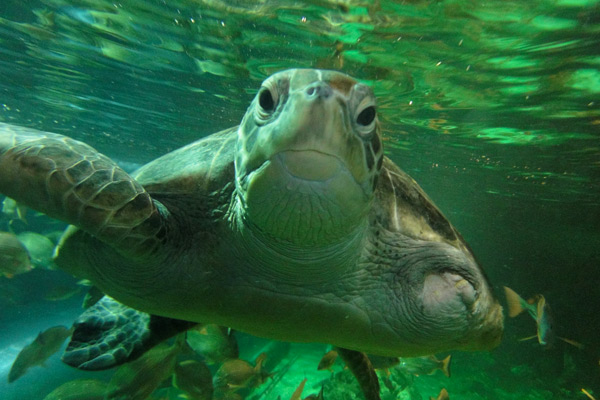Chris & Allyson vs. Australia (May 2012)
Day Five: Jogging tourism. Modern art. Hyde Park Barracks. Darling Harbor. Goodbye to Sydney.
Sydney has tons to see, but by our fifth day in Australia we had seen most of what we wanted to see. There's always more -- the zoo, shopping, theater, staggering around downtown drunk -- but short of taking surfing lessons and having a torrid affair with a local, there wasn't much left to create a significantly more-authentic experience. With a plane ride to Queensland waiting at the end of the day, we had 10 hours to relax and mop up what we could.
I started with a jog. The Sydney Harbor Bridge is very pedestrian friendly. Lots of people cross it on their way to work, and as an international goodwill ambassador I tried to sweat on as few of them as possible while crossing it.
The bridge links The Rocks, traditionally one of the slummier parts of town, to Kirribilli, one of the richest. Kirribilli has ritzy houses, lots of them with waterfront views; from that side of the harbor you're looking out at the skyscrapers of the business district, Circular Quay and the Opera House. The best view is reserved for the prime minister, whenever the prime minister wants a dirty weekend away from Canberra -- Kirribilli House, the PM's residence, sits on the point at the end of the neighborhood. You can't really tour it, but you can jog past it slowly and get suspicious looks from security.
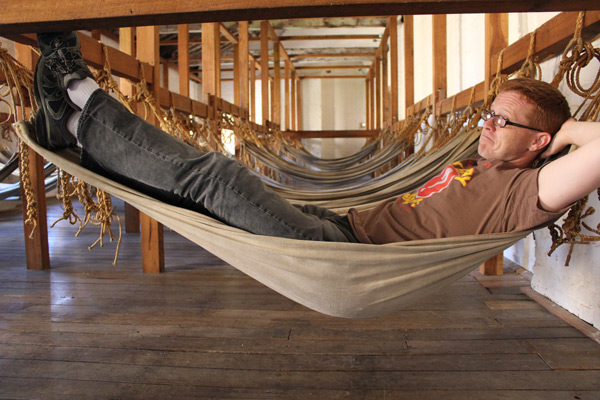
Chilling out at the Hyde Park Barracks.
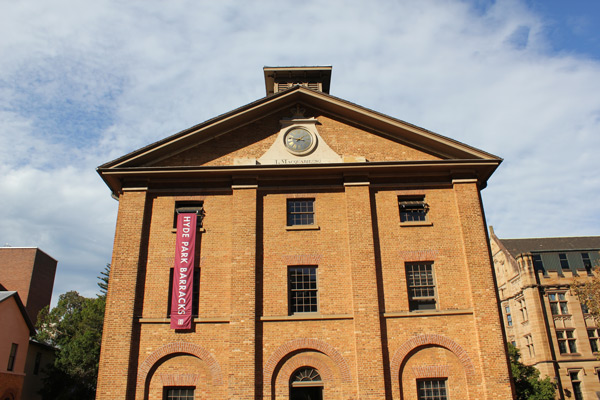
The exterior of the Hyde Park Barracks.
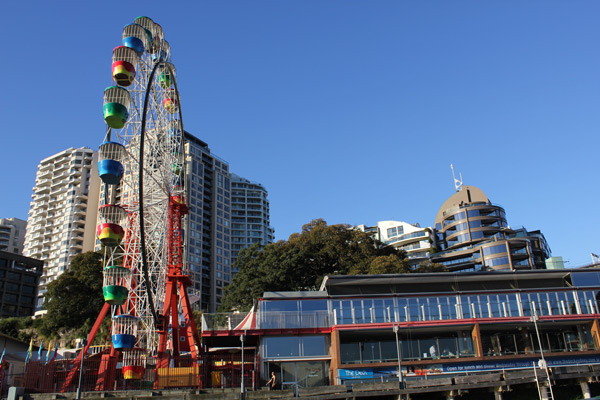
Rolling up on Luna Park.
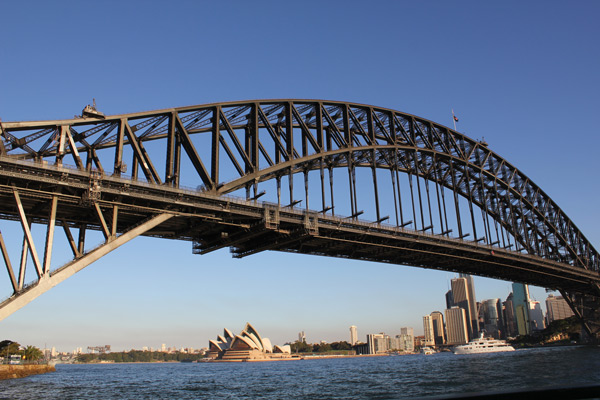
An up-close view of the Sydney Harbor Bridge.
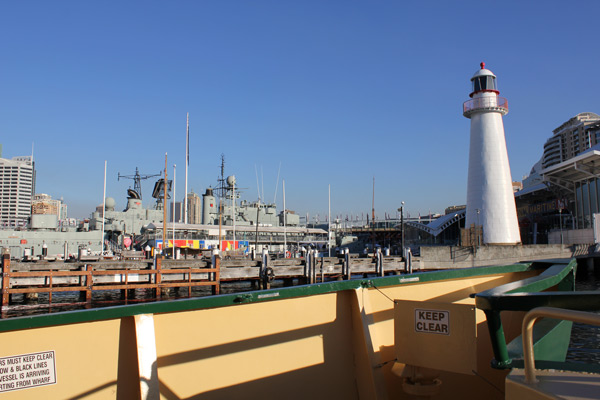
The lighthouse at Darling Harbor, Sydney.
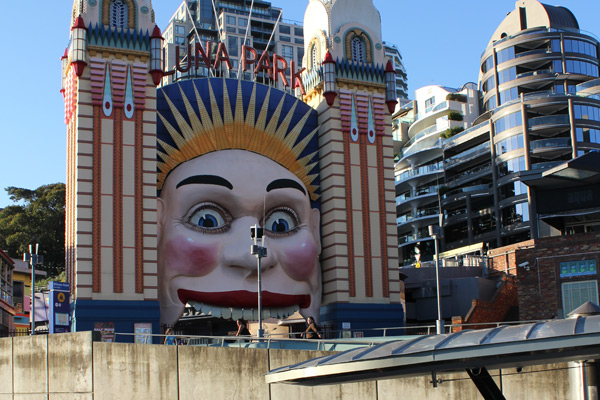
The tasteful entrance to Luna Park.
The other attraction at the rich end of the bridge is Luna Park. After bridge construction was finished, there was a nice abandoned worksite where supplies and machines for bridge construction were once kept. Enterprising geniuses used it to install one of the many knock-offs of Coney Island's famous Luna Park -- because nothing classes up a country quite like imitating Brooklyn. It was state-of-the-art when it opened, but with advancements in amusement park technology, the rides are now on par with the traveling carnivals that set up in strip-mall parking lots. Luna Park has more character, though, if only because you enter it through a giant mouth. That's how you know good times are on the way.
Chugging around an empty amusement park is a good way to get serial-murdered or involved in a Scooby-Doo mystery, so after a few minutes I left to run around the edge of Lavender Bay, where rich people moor their boats. Then I headed back over bridge to The Rocks and up to Observatory Hill. Back when clocks still sucked, harbor cities would put observatories on their highest hill, where ships could see them from miles away. The top of each observatory would have a "time ball," which would drop at an appointed hour to let mariners know to synchronize their Swatches.
And then there was the highlight of my exercise: Not far from the observatory, still on the hill but tucked under the Harbor Bridge, is the only surviving Victorian-era cast-iron urinal in the city. How many great men, how many generations fretted over splashback in this public accommodation? We are humbled in its presence.
It was good jogging tourism: I saw four things that ostensibly seem interesting, but not interesting enough to merit more than 5 minutes of my time. Efficiency is my anti-drug.
Allyson was either sleeping or having a torrid affair with a local while I was jogging, but when I returned she was having breakfast. We chatted a bit with a Canadian couple in the hotel breakfast area; they had quit their jobs and taken their very young daughter (she was around 4, and heavily invested in touching every item on the breakfast buffet) on a months-long odyssey involving lots of hotels and rental cars. So apparently, the jobs they quit paid fairly well. He was a surfer and was seeking out great waves, and his wife seemed OK with it. I personally would save my career-ending vacation until my child was old enough to appreciate the horrendous expense involved in bringing them along -- knowing that you're a lucky little **** builds character. But as we all know, the Canadian surfing community plays by its own rules. May the waves break always in their favor, and may that girl not end up working in a hemp store on Prince Edward Island.
After breakfast, we packed our stuff, left it at the hotel desk and then got to the next order of business. Allyson needed to relax.
And I mean that legitimately. My wife has back issues, and while our time on vacation was far less stressful than her days in the salt mine, she wanted to try something new in terms of relief. There was a massage place two blocks from the hotel that a friend actually recommended from her trip to Sydney. Allyson headed off for an hour of body manipulation, and I decided to wait for her in the Museum of Contemporary Art, just a few blocks away.
I like contemporary art. Even when it's bad it makes you think, plus you get the self-satisfaction of telling people you like contemporary art. I'm an even bigger fan of free museums, so this particular collection of contemporary art was phenomenal. Thinking back on it months later, I remember three things: a room lined floor to ceiling with pictures of ordinary people, each paired with a number indicating how much time is left in their life; a wall of changing color panels made from repurposed flip clocks; and some freaky slow-motion videos (by a man named Daniel Crooks) of people doing physical activity where various body parts blurred and stretched. Those were all part a temporary exhibit, so the only thing I can guarantee that you'll see is a bunch of art about how the white man stuck it to the aboriginals, in every way imaginable. White guilt is a growth industry in the art world.
When Allyson showed up, she was sporting body art: giant circular bruises all over her back. She received a "cupping" massage, which is less pervy than it sounds. A series of small cups was placed on her back, and then fire was somehow used to remove all the oxygen from the cups and create a suction seal with (and a giant bruise on) her skin. This magically relieves stress and makes you look like the victim in a nautilus attack. The East is full of mysterious and wondrous ways to mutilate your body in the name of relaxation. It's an exotic place.
Sticking with the relaxation theme, we walked to a place with many, many hammocks. Around 1819, the brain trust running Australia wondered: We're taking people convicted of ticky-tack offenses halfway around the world to a wilderness filled with venomous animals and using them as slave labor for a few decades; are we being too soft? Convicts had a bit of freedom to set up their own homes and live their own lives, but some inspectors looked at this as coddling the evildoers. So Gov. Macquarie had Francis Greenway -- an architect convicted of forgery -- put together the Hyde Park Barracks, where convicts could sleep in much-more-tightly supervised environment. Greenway's face is on some denomination of Australian money, because you want a forger on your currency.
The barracks were repurposed over the years into a home for destitute women, then into dingy government offices. But the building never died, and today it's a museum unto itself. They have displays on convict tools, the convict lifestyle, the overall convict labor movement and what ended it; there's a recreation of the hammock hall where hundreds of guys slept at a time. They even have a nice archaeological display dedicated to the many history-minded rats that kindly preserved chunks of artifacts inside the walls, so that schoolchildren might one day learn what kinds of buttons and toothpicks were used by 19th-century horse thieves (and then buy a stuffed rat in the gift shop). There's a very nice computer that lets you look up if you're descended from an Australian convict. I was disappointed that I am not.
Learning is hungry work, so we hoofed it from Hyde Park down to Darling Harbor, one of the only hotspots we hadn't seen. It used to be a commercial wharf, then was repurposed into a brownfield. A few years back, someone decided to drop a convention center, an aquarium and a few museums on the site. Some chain restaurants moved in, and it quickly became the exciting kind of destination that locals like to avoid because of all the tourists. We were there mostly for fine outdoor dining at a restaurant I do not remember.
Allyson had a huge frozen drink to close out the relax-a-thon, we did a little gawking at the dinner cruise boats, and then we took a ferry back to Circular Quay. Why not? It's a water city, and you might as well enjoy it via water. The ferry route ran under the Harbor Bridge, so we got the one perspective on the damn thing that we hadn't yet enjoyed. There were stops outside Luna Park and Lavender Bay, so Allyson got to enjoy a condensed version of my morning jog, without the heaving bosoms and occasional heat rash. Back near the hotel, we did a little souvenir shopping, had a beer at the Orient Hotel and met with the airport shuttle. An hour later, we were waiting in Sydney's adorably tiny airport.
Sydney has its charms. $10 beers are not one of them, but there's culture, history, nature and business all crammed in a very friendly metro area that's easy to traverse. It's the spot where Australia started and, if you're asking a person from Sydney, the place where its future lies. If you're asking a person from Melbourne, they'll call out those fey European nancies in Sydney as the stuck-up pricks that they really are.
That would be an argument for day nine, though. At this point, we had a very different kind of vacation waiting for us in Cairns. The beers were still going to be expensive, and there were going to be more Asian tourists, but there also might be koalas.
